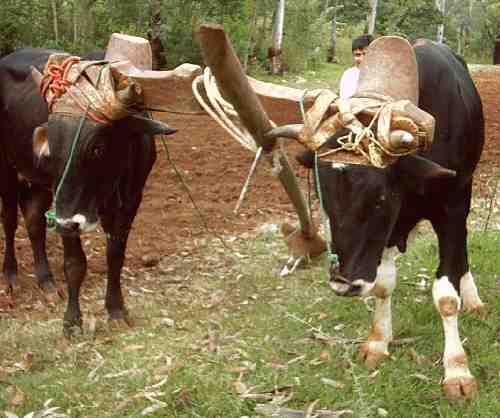|
The North Aisle
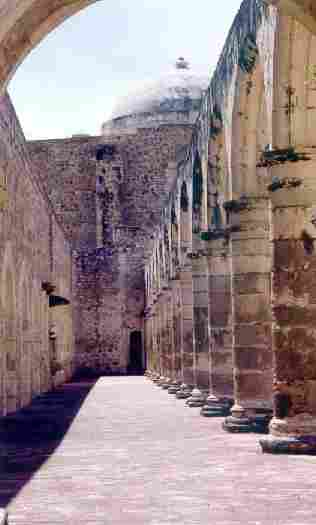 Take a trip to the unfinished monastery and church at
Cuilapan built on top of the old Zapotec temple (there is
still one small portion of the old painted floor visible),
and a carved stone in the wall records the date, 1555, in both
Zapotec and modern writing, and the date 1568 in Mixtec only.
The completion was halted by the Cortes family, the
hereditary Marquis of Oaxaca, in 1560. The second President
of Mexico (1829-30), Vicente Guerrero was executed in the
courtyard to the south of the monastery and church complex at
Cuilapan. Two years later his body was exhumed and
re-buried with great honor, and the pueblo took the name of
Cuilapan de Guerrero. Cuilapan is best followed by a visit
to the last Zapotec capital at Zaachila (with a traditional
Mexican lunch in between at a beautful old restaurant under
the trees.)
Take a trip to the unfinished monastery and church at
Cuilapan built on top of the old Zapotec temple (there is
still one small portion of the old painted floor visible),
and a carved stone in the wall records the date, 1555, in both
Zapotec and modern writing, and the date 1568 in Mixtec only.
The completion was halted by the Cortes family, the
hereditary Marquis of Oaxaca, in 1560. The second President
of Mexico (1829-30), Vicente Guerrero was executed in the
courtyard to the south of the monastery and church complex at
Cuilapan. Two years later his body was exhumed and
re-buried with great honor, and the pueblo took the name of
Cuilapan de Guerrero. Cuilapan is best followed by a visit
to the last Zapotec capital at Zaachila (with a traditional
Mexican lunch in between at a beautful old restaurant under
the trees.)
You can see Cortes' own house (now a museum) in the
city of Oaxaca, but the Cortes house at Cuilapan is now
reduced to a single wall.
The Unfinished Nave at Cuilapan
 At the far end of the nave is a dedicatory inscription carved
in the wall with the date 1555, written in both Latin and
Mixtec characters (year 10 Reed, day 11 Serpent on the left,
and year 10 Flint, day 11 Death on the right). 1555 is the
date (given by Burgoa) that Saayucu moved to Yuchacaa.
The name Cuilapan, derived from the Nahuatl name imported by
the Aztecs, Coyolapan, actually refers to three settlements,
spatially very close and over-lapping, but clearly separated
in time. First came the Zapotec settlement existing alongside
Monte Alban. A few pyramid remains from this settlement can
still be seen on the outskirts of modern Cuilapan. The
Zapoteco equivalent of Coyolapan is Quicopecua, meaning Bell
River, referring to the small bells fabricated from the fruit
of the coyol palm. The next phase was the Mixtec settlement
of Saayucu (meaning Below-Hill) at the foot of Monte Alban,
which moved to be adjacent to the site where the Dominicans
were to build the new monastery, and also adjacent to the
abandionned Zapotec site of Quicopecua. This third location
was named Yuchacaa (retaining the 'Bell River' name in
Mixteco.) Yuchacaa is the same site as modern Cuilapan, with
some overlap of the remains of Saayucu to the north, and
Quicopecua to the south.
The inscription on the monastery wall clearly refers to this
last move of the Mixtecs, but contrast the clear and firm
carving of the Mixteco dates with the hesitant inscription of
the newly learned Latin characters. See if you can find it,
on the far wall, to the right of the nave, about 6 ft.
above ground level.
At the far end of the nave is a dedicatory inscription carved
in the wall with the date 1555, written in both Latin and
Mixtec characters (year 10 Reed, day 11 Serpent on the left,
and year 10 Flint, day 11 Death on the right). 1555 is the
date (given by Burgoa) that Saayucu moved to Yuchacaa.
The name Cuilapan, derived from the Nahuatl name imported by
the Aztecs, Coyolapan, actually refers to three settlements,
spatially very close and over-lapping, but clearly separated
in time. First came the Zapotec settlement existing alongside
Monte Alban. A few pyramid remains from this settlement can
still be seen on the outskirts of modern Cuilapan. The
Zapoteco equivalent of Coyolapan is Quicopecua, meaning Bell
River, referring to the small bells fabricated from the fruit
of the coyol palm. The next phase was the Mixtec settlement
of Saayucu (meaning Below-Hill) at the foot of Monte Alban,
which moved to be adjacent to the site where the Dominicans
were to build the new monastery, and also adjacent to the
abandionned Zapotec site of Quicopecua. This third location
was named Yuchacaa (retaining the 'Bell River' name in
Mixteco.) Yuchacaa is the same site as modern Cuilapan, with
some overlap of the remains of Saayucu to the north, and
Quicopecua to the south.
The inscription on the monastery wall clearly refers to this
last move of the Mixtecs, but contrast the clear and firm
carving of the Mixteco dates with the hesitant inscription of
the newly learned Latin characters. See if you can find it,
on the far wall, to the right of the nave, about 6 ft.
above ground level.
A Mural of the Monks who First Inhabited Cuilapan

Inside the monastery building there are the remains of many
murals, all have decayed noticably in the last six years.
One of the most outstanding is the mural of portraits of the
early monks of Cuilapan. get there quickly, it is
disappearing fast. The monastery complex of Cuilapan was
seriously damaged in the earthquake of September 1999, and
approach to some of the ruins is now restricted.
The 'Scribe' of Cuilapan
 A Statuette thought to have been found at the ancient
Zapotec site, Quicopecua, at
Cuilapan has named 'the scribe' after its resemblance to
a known Egyptian portrait of a scribe in Ancient Egypt.
The writing on the headdress and chest are the dates 13 Water
and 13 Flint respectively in Mixteco. The significance of
these dates is unknown.
A Statuette thought to have been found at the ancient
Zapotec site, Quicopecua, at
Cuilapan has named 'the scribe' after its resemblance to
a known Egyptian portrait of a scribe in Ancient Egypt.
The writing on the headdress and chest are the dates 13 Water
and 13 Flint respectively in Mixteco. The significance of
these dates is unknown.
|
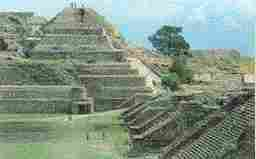 The modern city of Oaxaca is built on the site of an old
Aztec military fort, Huaxyaca, and received the rights of a
city, named Antequera, by royal letters patent of Charles V of
Spain. The three arms of the valley of Oaxaca,
which extend for about 20 miles (30 Km.), are filled with
interesting places to visit during your vacation.
The modern city of Oaxaca is built on the site of an old
Aztec military fort, Huaxyaca, and received the rights of a
city, named Antequera, by royal letters patent of Charles V of
Spain. The three arms of the valley of Oaxaca,
which extend for about 20 miles (30 Km.), are filled with
interesting places to visit during your vacation.
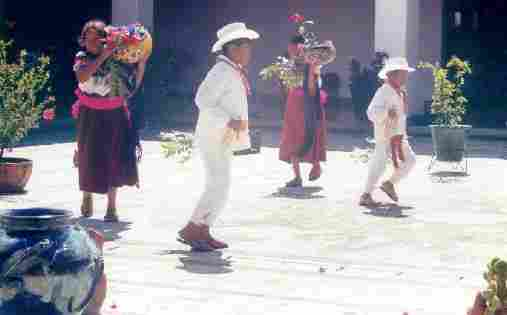 Traditional dancing performed by children at a roadside
restaurant near Teotitlan del Valle on a Sunday afternoon
Traditional dancing performed by children at a roadside
restaurant near Teotitlan del Valle on a Sunday afternoon
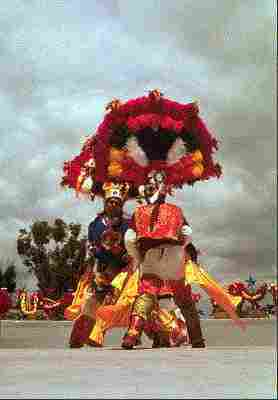 Costume, flowers and dancing are an important part of the
local Zapotec culture all year round, but the most important
festival of the year is the Guelaguetza in July, the two
weekends following the anniversary of the death of Benito
Juarez, perhaps Mexico's most famous (and consistent) president
on July 18th 18XX. The festival ends with a procession through
the city starting at Santo Domingo church and proceeding to the
Zocolo down Macedonia Alcala.
Costume, flowers and dancing are an important part of the
local Zapotec culture all year round, but the most important
festival of the year is the Guelaguetza in July, the two
weekends following the anniversary of the death of Benito
Juarez, perhaps Mexico's most famous (and consistent) president
on July 18th 18XX. The festival ends with a procession through
the city starting at Santo Domingo church and proceeding to the
Zocolo down Macedonia Alcala.
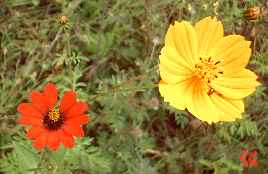
 At about 4:00 pm. on the 3rd. and 4th. Saturdays in July, the
Guelaguetza procession starts to form in Macedonia Alcala in
front of the church of Santo Domingo.
At about 4:00 pm. on the 3rd. and 4th. Saturdays in July, the
Guelaguetza procession starts to form in Macedonia Alcala in
front of the church of Santo Domingo.
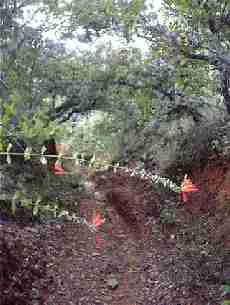
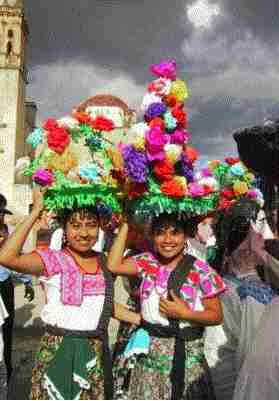
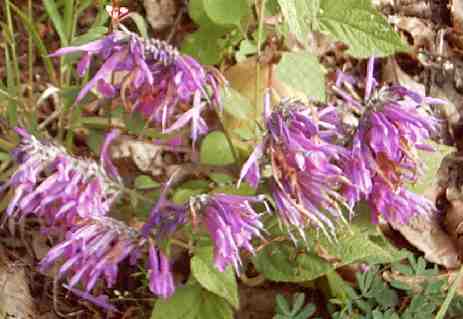
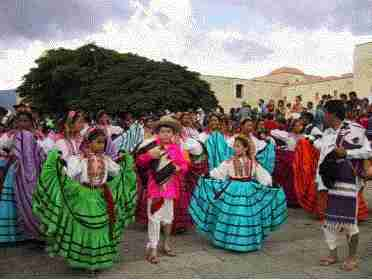 Three children prepare for the procession
Three children prepare for the procession
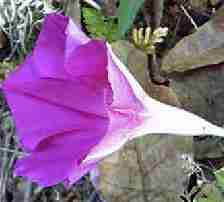
 The traditions of costumes and dancing are learned at
a very early age in the Valley of Oaxaca.
The traditions of costumes and dancing are learned at
a very early age in the Valley of Oaxaca.

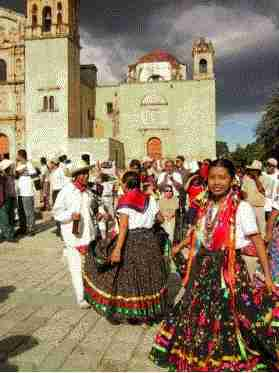 The Guelagueza takes place early in the rainy season at Oaxaca.
But there are still beautiful days in July, with storms
approaching in the late afternoon and evening to add to the
drama of the procession.
The Guelagueza takes place early in the rainy season at Oaxaca.
But there are still beautiful days in July, with storms
approaching in the late afternoon and evening to add to the
drama of the procession.
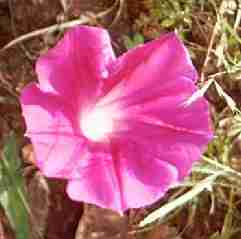
 The archaeological record in the region is unparalleled:
at the center there is the ancient city of Monte Alban
sculpted out of the mountain itself, with its massive pyramids
and temples, in the eastern valley there is the City of the
Dead at Mitla, Yagul, Lambityeco and Dainzu, in the Etla Valley
the first Zapotec capital at San Jose Mogote, and in the Zimatlan
Valley, at Cuilapan, the successor to Monte Alban, and the last
Zapotec capital at Zaachila.
The archaeological record in the region is unparalleled:
at the center there is the ancient city of Monte Alban
sculpted out of the mountain itself, with its massive pyramids
and temples, in the eastern valley there is the City of the
Dead at Mitla, Yagul, Lambityeco and Dainzu, in the Etla Valley
the first Zapotec capital at San Jose Mogote, and in the Zimatlan
Valley, at Cuilapan, the successor to Monte Alban, and the last
Zapotec capital at Zaachila.
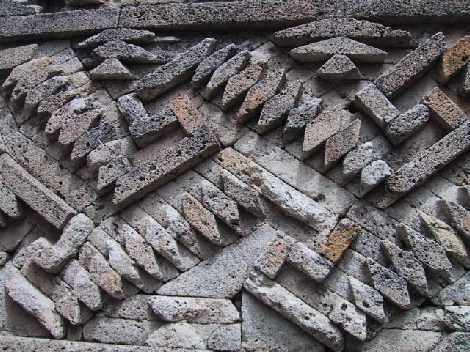 The stone work at Mitla is characterized by a complex fretwork
of carefully shaped tiny stones covering the massive walls with
geometric patterns.
The stone work at Mitla is characterized by a complex fretwork
of carefully shaped tiny stones covering the massive walls with
geometric patterns.
 Low doorways with heavy stone lintels are frequent in the Mitla
Palace, and decoration is everywhere. See
Low doorways with heavy stone lintels are frequent in the Mitla
Palace, and decoration is everywhere. See
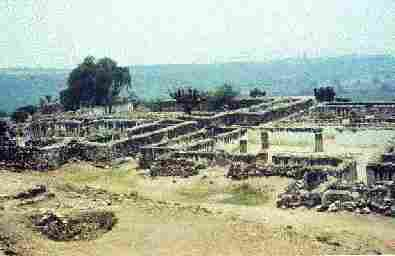 Also in the Mitla valley, are the ancient Zapotec center of
the ceremonial ball game, pelota, at Dainzu,
the quiet beauty of Yagul with its hill fort
and palace of the seven courtyards, and the later site of
Lambityeco. They are all easily accessible from the hotel by
car or coach. See
Also in the Mitla valley, are the ancient Zapotec center of
the ceremonial ball game, pelota, at Dainzu,
the quiet beauty of Yagul with its hill fort
and palace of the seven courtyards, and the later site of
Lambityeco. They are all easily accessible from the hotel by
car or coach. See
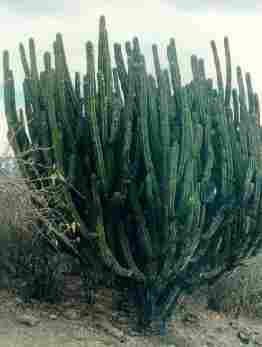 Also at Yagul you can see the many very old giant cactus.
Also at Yagul you can see the many very old giant cactus.
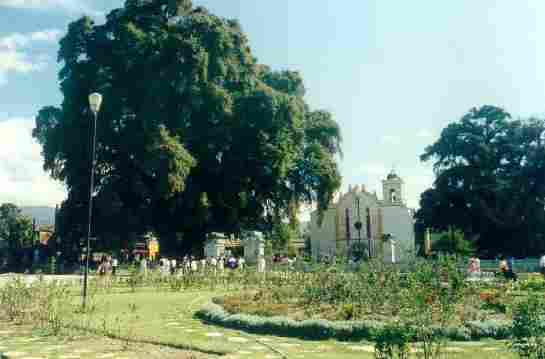
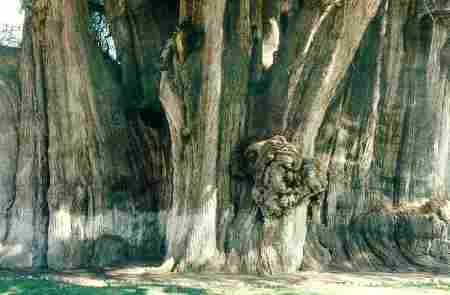 The Tule tree is more than 2000 years old, it's height is
42 meters (about 136 feet), the diameter of the huge trunk
is 14 meters (about 45 feet)
The Tule tree is more than 2000 years old, it's height is
42 meters (about 136 feet), the diameter of the huge trunk
is 14 meters (about 45 feet)
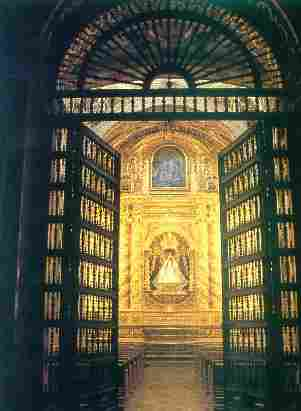 Returning to the city of Oaxaca, you must visit the Santo Domingo
church and convent complex. In the old convent you can see the
gold treasures recovered from the tombs
at Monte Alban which are all on display in the
Returning to the city of Oaxaca, you must visit the Santo Domingo
church and convent complex. In the old convent you can see the
gold treasures recovered from the tombs
at Monte Alban which are all on display in the
 The assembly of the parade for the Guelaguetza takes place in
front of the Church of Santo Domingo on Macedonia Alcala.
During the preparations, those taking part are always very happy
to explain the symbolism of the costumes and dances, and to pose
for photographs. The preparations commence at about 4 pm, and
the parade starts round about 6 pm. As the Guelagetza comes
at the start of the rainy season in Oaxaca, the preparations
and the parade are often to be seen under very dramatic skies.
The parade moves off down Macedonia Alcala towards the Zocolo.
The assembly of the parade for the Guelaguetza takes place in
front of the Church of Santo Domingo on Macedonia Alcala.
During the preparations, those taking part are always very happy
to explain the symbolism of the costumes and dances, and to pose
for photographs. The preparations commence at about 4 pm, and
the parade starts round about 6 pm. As the Guelagetza comes
at the start of the rainy season in Oaxaca, the preparations
and the parade are often to be seen under very dramatic skies.
The parade moves off down Macedonia Alcala towards the Zocolo.
 An attempt is being made to preserve the native flora of
the Oaxaca valley and the surrounding mountains. Examples
of many of them are to be seen in the ethnobotanical gardens
located in the grounds of Santo Domingo, in what was for many
years used as an army barracks and parade ground.
An attempt is being made to preserve the native flora of
the Oaxaca valley and the surrounding mountains. Examples
of many of them are to be seen in the ethnobotanical gardens
located in the grounds of Santo Domingo, in what was for many
years used as an army barracks and parade ground.

 Take a trip to the unfinished monastery and church at
Cuilapan built on top of the old Zapotec temple (there is
still one small portion of the old painted floor visible),
and a carved stone in the wall records the date, 1555, in both
Zapotec and modern writing, and the date 1568 in Mixtec only.
The completion was halted by the Cortes family, the
hereditary Marquis of Oaxaca, in 1560. The second President
of Mexico (1829-30), Vicente Guerrero was executed in the
courtyard to the south of the monastery and church complex at
Cuilapan. Two years later his body was exhumed and
re-buried with great honor, and the pueblo took the name of
Cuilapan de Guerrero. Cuilapan is best followed by a visit
to the last Zapotec capital at Zaachila (with a traditional
Mexican lunch in between at a beautful old restaurant under
the trees.)
Take a trip to the unfinished monastery and church at
Cuilapan built on top of the old Zapotec temple (there is
still one small portion of the old painted floor visible),
and a carved stone in the wall records the date, 1555, in both
Zapotec and modern writing, and the date 1568 in Mixtec only.
The completion was halted by the Cortes family, the
hereditary Marquis of Oaxaca, in 1560. The second President
of Mexico (1829-30), Vicente Guerrero was executed in the
courtyard to the south of the monastery and church complex at
Cuilapan. Two years later his body was exhumed and
re-buried with great honor, and the pueblo took the name of
Cuilapan de Guerrero. Cuilapan is best followed by a visit
to the last Zapotec capital at Zaachila (with a traditional
Mexican lunch in between at a beautful old restaurant under
the trees.)
 At the far end of the nave is a dedicatory inscription carved
in the wall with the date 1555, written in both Latin and
Mixtec characters (year 10 Reed, day 11 Serpent on the left,
and year 10 Flint, day 11 Death on the right). 1555 is the
date (given by Burgoa) that Saayucu moved to Yuchacaa.
The name Cuilapan, derived from the Nahuatl name imported by
the Aztecs, Coyolapan, actually refers to three settlements,
spatially very close and over-lapping, but clearly separated
in time. First came the Zapotec settlement existing alongside
Monte Alban. A few pyramid remains from this settlement can
still be seen on the outskirts of modern Cuilapan. The
Zapoteco equivalent of Coyolapan is Quicopecua, meaning Bell
River, referring to the small bells fabricated from the fruit
of the coyol palm. The next phase was the Mixtec settlement
of Saayucu (meaning Below-Hill) at the foot of Monte Alban,
which moved to be adjacent to the site where the Dominicans
were to build the new monastery, and also adjacent to the
abandionned Zapotec site of Quicopecua. This third location
was named Yuchacaa (retaining the 'Bell River' name in
Mixteco.) Yuchacaa is the same site as modern Cuilapan, with
some overlap of the remains of Saayucu to the north, and
Quicopecua to the south.
The inscription on the monastery wall clearly refers to this
last move of the Mixtecs, but contrast the clear and firm
carving of the Mixteco dates with the hesitant inscription of
the newly learned Latin characters. See if you can find it,
on the far wall, to the right of the nave, about 6 ft.
above ground level.
At the far end of the nave is a dedicatory inscription carved
in the wall with the date 1555, written in both Latin and
Mixtec characters (year 10 Reed, day 11 Serpent on the left,
and year 10 Flint, day 11 Death on the right). 1555 is the
date (given by Burgoa) that Saayucu moved to Yuchacaa.
The name Cuilapan, derived from the Nahuatl name imported by
the Aztecs, Coyolapan, actually refers to three settlements,
spatially very close and over-lapping, but clearly separated
in time. First came the Zapotec settlement existing alongside
Monte Alban. A few pyramid remains from this settlement can
still be seen on the outskirts of modern Cuilapan. The
Zapoteco equivalent of Coyolapan is Quicopecua, meaning Bell
River, referring to the small bells fabricated from the fruit
of the coyol palm. The next phase was the Mixtec settlement
of Saayucu (meaning Below-Hill) at the foot of Monte Alban,
which moved to be adjacent to the site where the Dominicans
were to build the new monastery, and also adjacent to the
abandionned Zapotec site of Quicopecua. This third location
was named Yuchacaa (retaining the 'Bell River' name in
Mixteco.) Yuchacaa is the same site as modern Cuilapan, with
some overlap of the remains of Saayucu to the north, and
Quicopecua to the south.
The inscription on the monastery wall clearly refers to this
last move of the Mixtecs, but contrast the clear and firm
carving of the Mixteco dates with the hesitant inscription of
the newly learned Latin characters. See if you can find it,
on the far wall, to the right of the nave, about 6 ft.
above ground level.

 A Statuette thought to have been found at the ancient
Zapotec site, Quicopecua, at
Cuilapan has named 'the scribe' after its resemblance to
a known Egyptian portrait of a scribe in Ancient Egypt.
The writing on the headdress and chest are the dates 13 Water
and 13 Flint respectively in Mixteco. The significance of
these dates is unknown.
A Statuette thought to have been found at the ancient
Zapotec site, Quicopecua, at
Cuilapan has named 'the scribe' after its resemblance to
a known Egyptian portrait of a scribe in Ancient Egypt.
The writing on the headdress and chest are the dates 13 Water
and 13 Flint respectively in Mixteco. The significance of
these dates is unknown.
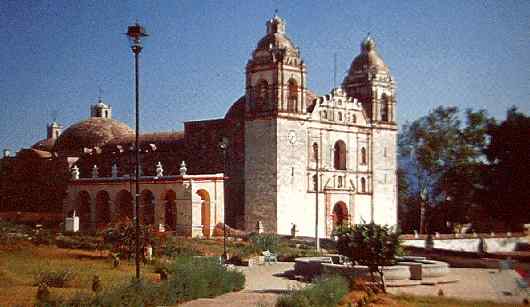 Turning back to the Mitla valley, there is a well preserved
sixteenth century church at Tlacochahuaya, still used for
regular services.
Turning back to the Mitla valley, there is a well preserved
sixteenth century church at Tlacochahuaya, still used for
regular services.
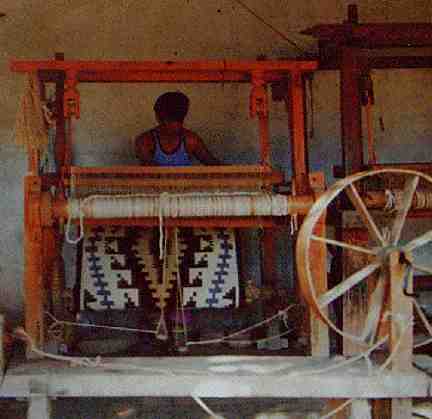 Teotitlan del Valle is the center of Oaxacan rug-weaving,
and you can see the old looms in operation.
Teotitlan del Valle is the center of Oaxacan rug-weaving,
and you can see the old looms in operation.
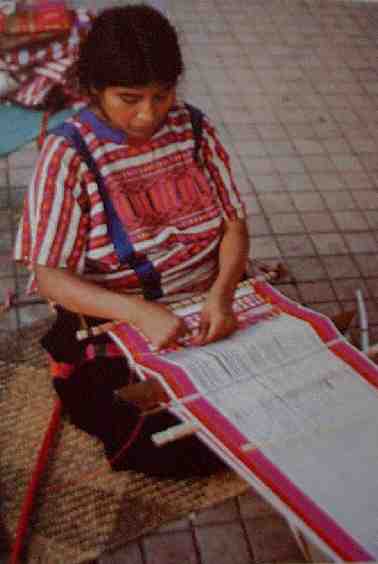 With luck you might also see the old 'back-strap loom' in
operation.
With luck you might also see the old 'back-strap loom' in
operation.
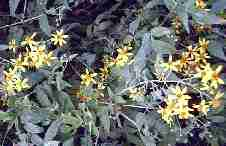


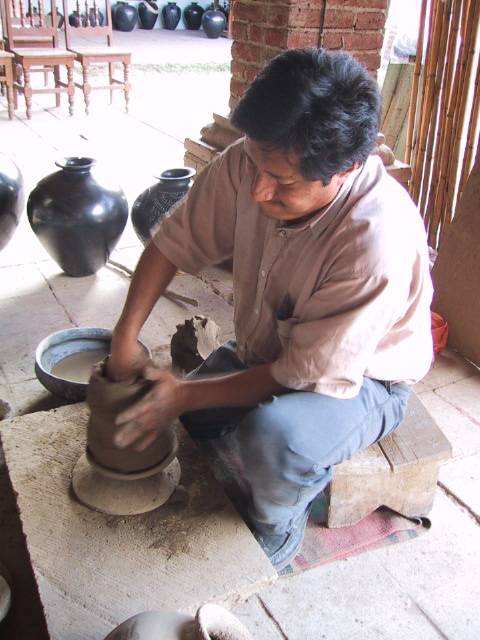 Dona Rosa's son demonstrates the art of hand-throwing the black
pottery, without a potters wheel at San Bartolo Coyotepec.
The potter spins the pot with one hand while working the clay
with the other.
Dona Rosa's son demonstrates the art of hand-throwing the black
pottery, without a potters wheel at San Bartolo Coyotepec.
The potter spins the pot with one hand while working the clay
with the other.
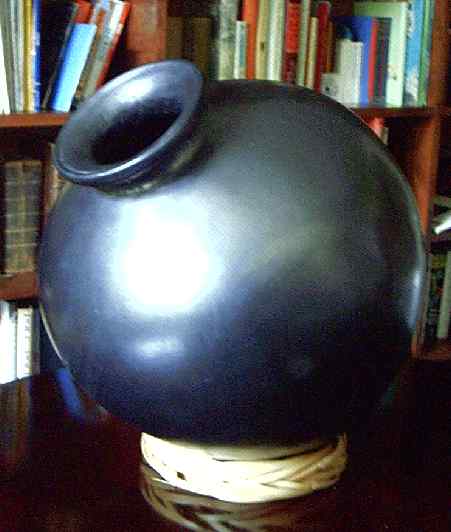 The final product is a beautiful pot.
The final product is a beautiful pot.

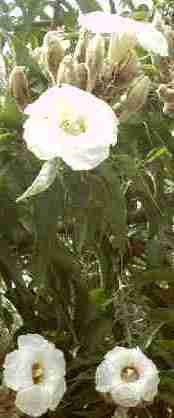
 The craft of making birdcages from carizo (the local bamboo)
at San Juan Guelavia
is handed down from father to son. The son (now grown up)
made ours, the parakeets loved it and soon ate it.
The craft of making birdcages from carizo (the local bamboo)
at San Juan Guelavia
is handed down from father to son. The son (now grown up)
made ours, the parakeets loved it and soon ate it.
 See the house on the Avenido Pino Suarez where D H Lawrence
lived and wrote "The Plumed Serpent"; the house he
immortalized in 'Mornings in Mexico'. It was originally
numbered 43, but was later renumbered to 600,`. It still
exists as a private residence. The house originally belonged
to the English Rickard family who donated the old Mixtec
"Codex Rickard" to the Royal Ontario Museum in Toronto.
Although Lawrence lost his way and failed to find San Felipe
del Agua on his Sunday walk, he did reach Huayapan on his
"Walk to Huayapan"
- and so can you, if you wish.
See the house on the Avenido Pino Suarez where D H Lawrence
lived and wrote "The Plumed Serpent"; the house he
immortalized in 'Mornings in Mexico'. It was originally
numbered 43, but was later renumbered to 600,`. It still
exists as a private residence. The house originally belonged
to the English Rickard family who donated the old Mixtec
"Codex Rickard" to the Royal Ontario Museum in Toronto.
Although Lawrence lost his way and failed to find San Felipe
del Agua on his Sunday walk, he did reach Huayapan on his
"Walk to Huayapan"
- and so can you, if you wish.

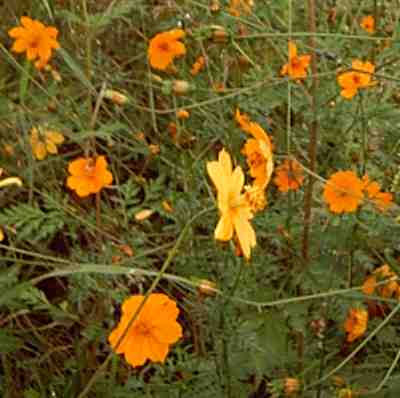
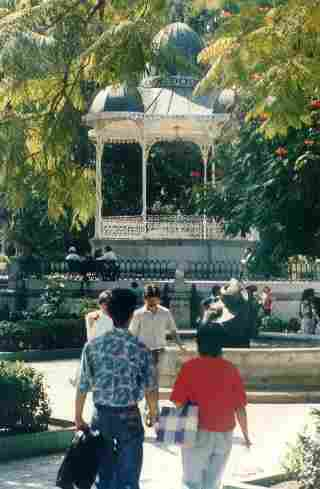 And if all this sounds just too much:
visit the Zocolo with its bandstand, in the center
of the city and enjoy the leisure of watching people
with a drink in front of you at one of the many
restaurants lining the square. Aldous Huxley
visited here in the late 1920's and for entertainment was
driven by his host in one of Oaxaca's first automobiles,
round and round the Zocolo for two hours. He found this got
a little tedious, but the Zocolo is now closed to traffic,
and it is very easy to sit and watch for two hours.
And if all this sounds just too much:
visit the Zocolo with its bandstand, in the center
of the city and enjoy the leisure of watching people
with a drink in front of you at one of the many
restaurants lining the square. Aldous Huxley
visited here in the late 1920's and for entertainment was
driven by his host in one of Oaxaca's first automobiles,
round and round the Zocolo for two hours. He found this got
a little tedious, but the Zocolo is now closed to traffic,
and it is very easy to sit and watch for two hours.
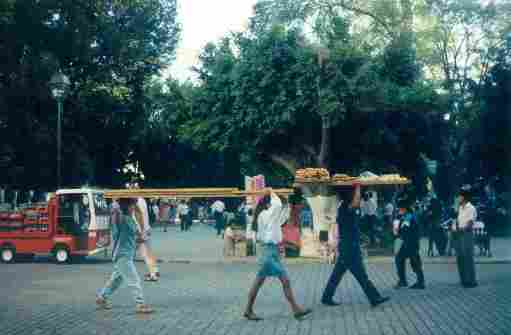 If you are very early (around 10 a.m.!), you might see
vendors arriving to set up a stall.
If you are very early (around 10 a.m.!), you might see
vendors arriving to set up a stall.
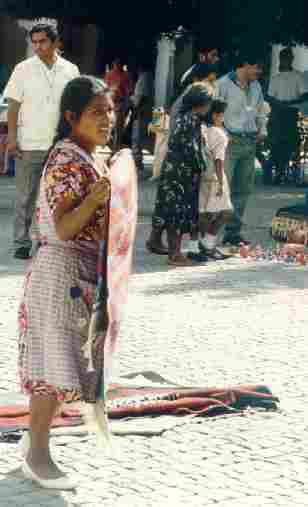 Or you might just possibly be persuaded to buy a Zapotecan
rug to take home with you.
Or you might just possibly be persuaded to buy a Zapotecan
rug to take home with you.
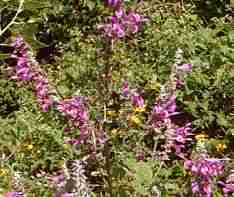
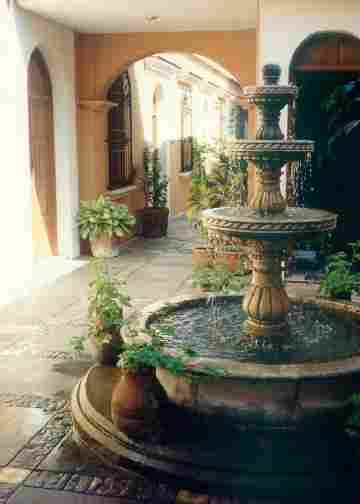 Or stroll around the city and discover for yourself
small corners with sights like this.
Or stroll around the city and discover for yourself
small corners with sights like this.
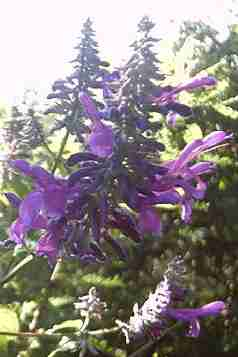
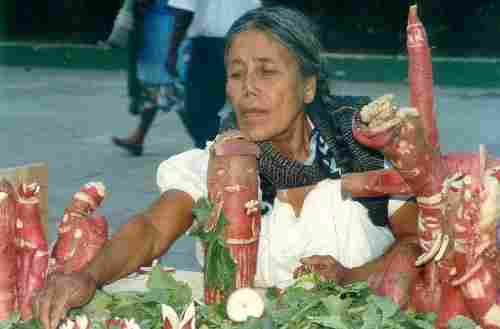
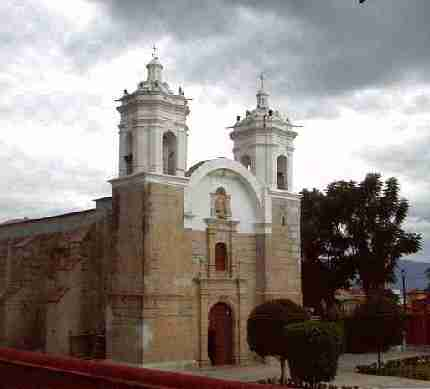 If you feel a little more energetic, take a short, quiet walk,
up through the old pueblo of San Felipe del Agua, through the
local zocolo, with its church,
If you feel a little more energetic, take a short, quiet walk,
up through the old pueblo of San Felipe del Agua, through the
local zocolo, with its church,
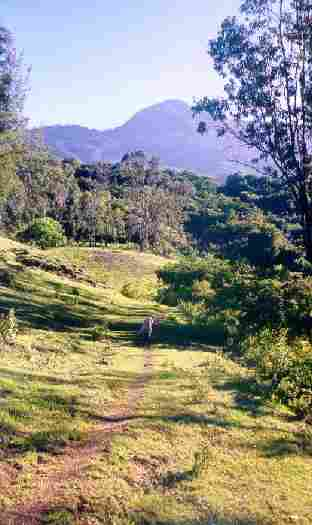 to the Parque Comunal on quiet narrow
trails to see the wild flowers at the end of the rainy season.
to the Parque Comunal on quiet narrow
trails to see the wild flowers at the end of the rainy season.
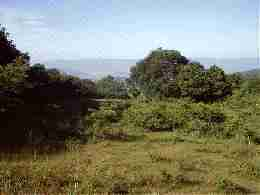
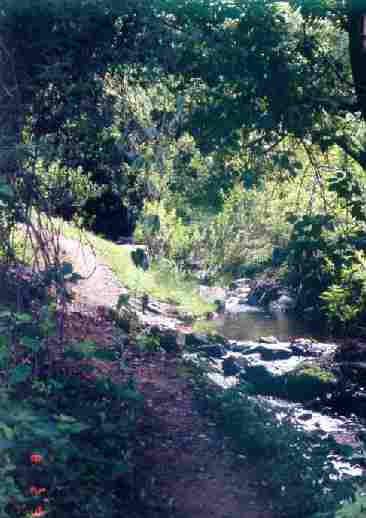 and into the Benito Juarez National Park for a picnic by one
of the beautiful streams (which run all year round.)
and into the Benito Juarez National Park for a picnic by one
of the beautiful streams (which run all year round.)

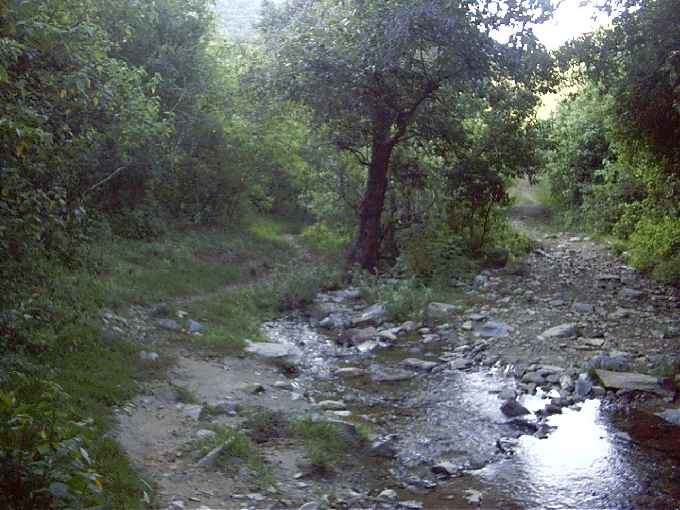
 and waterfalls. A popular short walk is up the valley of
the San Felipe creek - the Rio Grande - to the 'Cascada',
a major waterfall at the head of the valley, about 3 miles
above the pueblo.
and waterfalls. A popular short walk is up the valley of
the San Felipe creek - the Rio Grande - to the 'Cascada',
a major waterfall at the head of the valley, about 3 miles
above the pueblo.
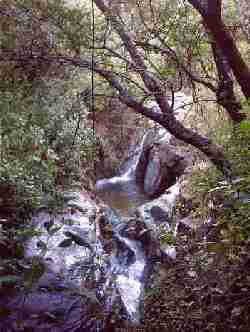
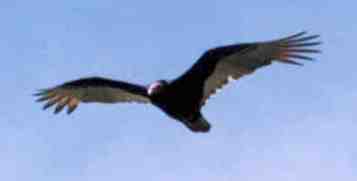 or watch the huge zopilote birds,
or watch the huge zopilote birds,
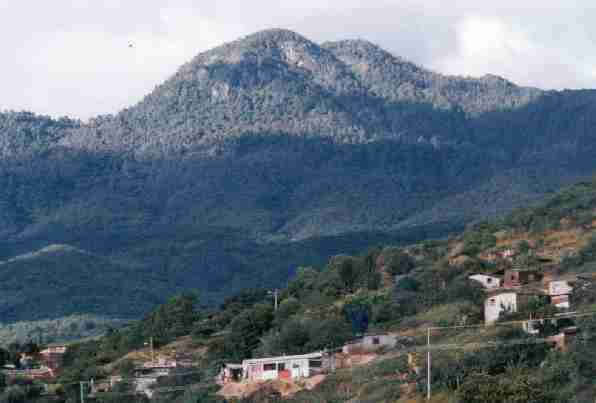


 High on the west ridge of the valley is a simple stone
memorial to Benito Juarez with the inscription "El respeto
al direcho ajeno es la paz" - respect for the rights of others
is peace. That the sentiment might well be an echo from St.
Augustine, encountered during his early training for the church,
does not detract from its value.
High on the west ridge of the valley is a simple stone
memorial to Benito Juarez with the inscription "El respeto
al direcho ajeno es la paz" - respect for the rights of others
is peace. That the sentiment might well be an echo from St.
Augustine, encountered during his early training for the church,
does not detract from its value.

